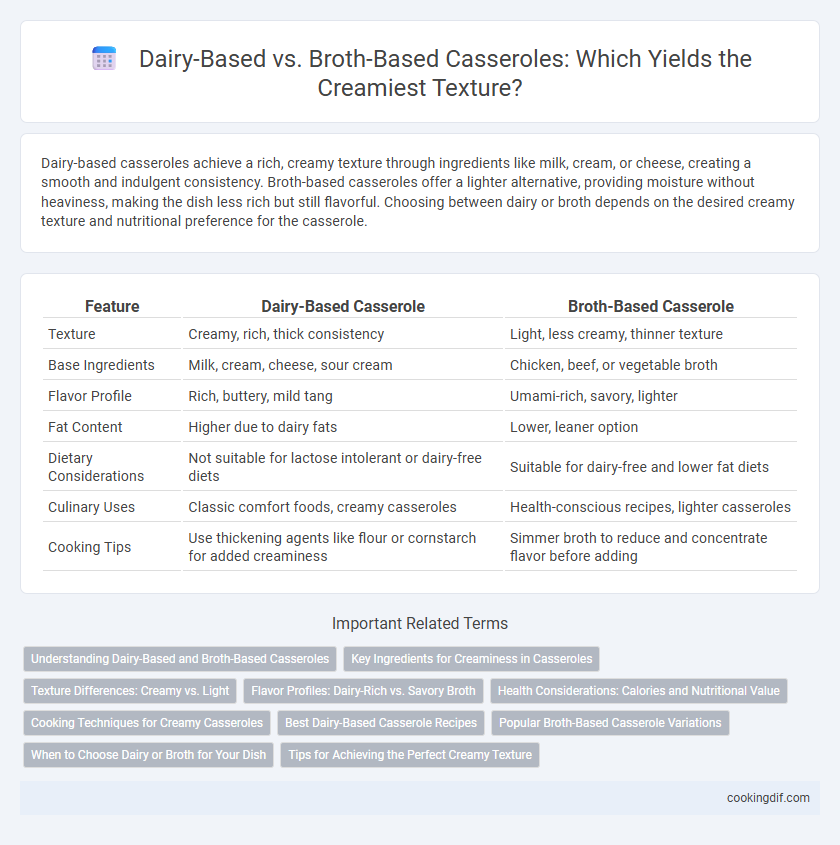Dairy-based casseroles achieve a rich, creamy texture through ingredients like milk, cream, or cheese, creating a smooth and indulgent consistency. Broth-based casseroles offer a lighter alternative, providing moisture without heaviness, making the dish less rich but still flavorful. Choosing between dairy or broth depends on the desired creamy texture and nutritional preference for the casserole.
Table of Comparison
| Feature | Dairy-Based Casserole | Broth-Based Casserole |
|---|---|---|
| Texture | Creamy, rich, thick consistency | Light, less creamy, thinner texture |
| Base Ingredients | Milk, cream, cheese, sour cream | Chicken, beef, or vegetable broth |
| Flavor Profile | Rich, buttery, mild tang | Umami-rich, savory, lighter |
| Fat Content | Higher due to dairy fats | Lower, leaner option |
| Dietary Considerations | Not suitable for lactose intolerant or dairy-free diets | Suitable for dairy-free and lower fat diets |
| Culinary Uses | Classic comfort foods, creamy casseroles | Health-conscious recipes, lighter casseroles |
| Cooking Tips | Use thickening agents like flour or cornstarch for added creaminess | Simmer broth to reduce and concentrate flavor before adding |
Understanding Dairy-Based and Broth-Based Casseroles
Dairy-based casseroles achieve a creamy texture by incorporating ingredients such as milk, cream, cheese, or sour cream, which add richness and smoothness to the dish. Broth-based casseroles rely on savory stock or broth as the liquid component, producing a lighter, more flavorful base with less fat content. Selecting between dairy-based and broth-based casseroles depends on the desired creaminess and calorie level, with dairy providing fullness and broth offering a subtle, savory profile.
Key Ingredients for Creaminess in Casseroles
Dairy-based casseroles achieve a rich, creamy texture primarily through ingredients like heavy cream, sour cream, cream cheese, or evaporated milk, which add thickness and velvety mouthfeel. Broth-based casseroles rely on a combination of butter, flour (as a roux), and sometimes a splash of dairy to create a creamy sauce without overpowering the dish with dairy flavors. The choice between dairy and broth bases impacts not only the texture but also the depth of flavor, with dairy enhancing richness and broth providing a lighter, savory foundation for the casserole.
Texture Differences: Creamy vs. Light
Dairy-based casseroles achieve a rich, creamy texture by incorporating ingredients like milk, cheese, or sour cream, which thicken the dish and create a smooth mouthfeel. Broth-based casseroles rely on stock or broth, resulting in a lighter, more fluid consistency with distinct ingredient separation and less richness. Texture differences influence the overall sensory experience, with creamy casseroles offering a luxurious bite and broth-based versions providing a more delicate finish.
Flavor Profiles: Dairy-Rich vs. Savory Broth
Dairy-based casseroles deliver a rich, creamy texture with flavors rooted in butter, cheese, and cream that create a smooth, indulgent mouthfeel. Broth-based casseroles emphasize a lighter, savory profile enhanced by herbs, spices, and umami-rich stocks that deepen complexity without heaviness. Choosing between dairy-rich and savory broth shifts the dish's taste from velvety and comforting to vibrant and aromatic, catering to diverse palate preferences.
Health Considerations: Calories and Nutritional Value
Dairy-based casseroles typically contain higher calories and fat due to ingredients like cream, cheese, and milk, which contribute to a rich and creamy texture but may increase saturated fat intake. Broth-based casseroles offer a lighter alternative with fewer calories and less fat, making them suitable for those seeking lower calorie options without sacrificing moisture and flavor. Choosing broth over dairy can enhance nutritional value by reducing saturated fat while still maintaining a satisfying texture through added vegetables and lean proteins.
Cooking Techniques for Creamy Casseroles
Dairy-based casseroles achieve a rich and creamy texture by incorporating ingredients such as heavy cream, sour cream, or cheese, which melt and thicken during baking to create a luscious consistency. Broth-based casseroles rely on reduction techniques and the addition of thickening agents like flour or cornstarch to develop a savory, creamy sauce without the heaviness of dairy. Proper layering, gentle simmering, and gradual heat application are essential cooking techniques to enhance creaminess and prevent curdling or separation in both casserole types.
Best Dairy-Based Casserole Recipes
Dairy-based casseroles achieve a rich and creamy texture by incorporating ingredients like heavy cream, sour cream, cream cheese, or shredded cheese, which melt and blend seamlessly during baking to produce a luscious consistency. Popular dairy-based casserole recipes include classic chicken tetrazzini, broccoli cheddar casserole, and creamy tuna noodle casserole, all relying on milk or cream as the base for smooth, velvety sauces. These dishes emphasize the use of high-fat dairy products to enhance moisture retention and flavor depth, differentiating them significantly from lighter, broth-based casseroles.
Popular Broth-Based Casserole Variations
Broth-based casseroles such as chicken and wild rice or beef and vegetable offer a lighter alternative with a rich, savory depth that contrasts with the heavier creaminess of dairy-based versions. Popular broth-based variations often incorporate ingredients like mushrooms, herbs, and soy sauce to enhance umami flavors while maintaining a tender texture. These recipes provide a nutritious, lower-fat option that still delivers satisfying moisture and complexity in every bite.
When to Choose Dairy or Broth for Your Dish
Dairy-based casseroles create a rich, creamy texture ideal for dishes requiring a smooth, velvety mouthfeel, such as potato or chicken casseroles, where cream, milk, or cheese enhances flavor and tenderness. Broth-based casseroles are preferable when a lighter, less rich consistency is desired, allowing the natural taste of vegetables or meats to shine without overpowering creaminess. Choosing dairy supports indulgent, comforting meals, while broth suits health-conscious recipes or when balancing strong, savory ingredients.
Tips for Achieving the Perfect Creamy Texture
Using dairy-based ingredients such as heavy cream, sour cream, or cream cheese enhances the casserole's richness and smoothness, creating a luscious creamy texture. For broth-based casseroles, adding a roux or cornstarch slurry is essential to thicken the sauce and avoid a watery consistency. Incorporating grated cheese or a touch of butter at the end of cooking boosts creaminess and provides a silky finish.
Dairy-based vs broth-based casserole for creamy texture Infographic

 cookingdif.com
cookingdif.com